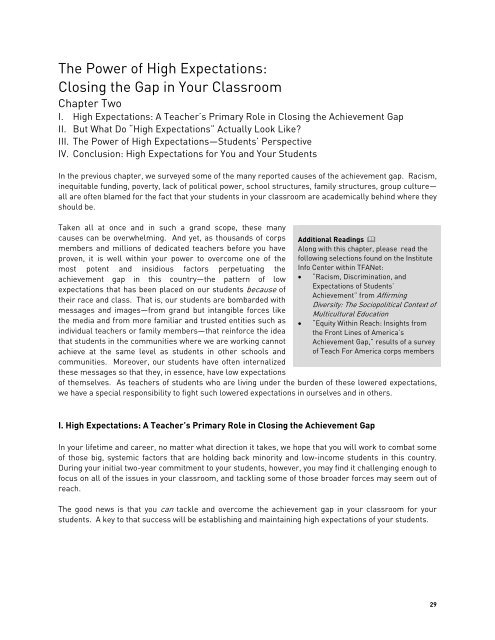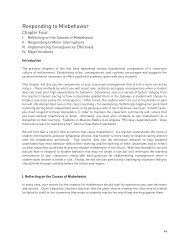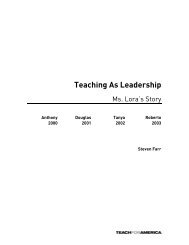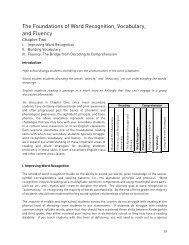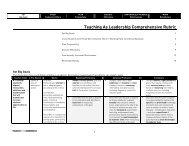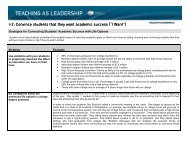The Power of High Expectations - Teaching As Leadership
The Power of High Expectations - Teaching As Leadership
The Power of High Expectations - Teaching As Leadership
You also want an ePaper? Increase the reach of your titles
YUMPU automatically turns print PDFs into web optimized ePapers that Google loves.
<strong>The</strong> <strong>Power</strong> <strong>of</strong> <strong>High</strong> <strong>Expectations</strong>:<br />
Closing the Gap in Your Classroom<br />
Chapter Two<br />
I. <strong>High</strong> <strong>Expectations</strong>: A Teacher’s Primary Role in Closing the Achievement Gap<br />
II. But What Do “<strong>High</strong> <strong>Expectations</strong>” Actually Look Like?<br />
III. <strong>The</strong> <strong>Power</strong> <strong>of</strong> <strong>High</strong> <strong>Expectations</strong>—Students’ Perspective<br />
IV. Conclusion: <strong>High</strong> <strong>Expectations</strong> for You and Your Students<br />
In the previous chapter, we surveyed some <strong>of</strong> the many reported causes <strong>of</strong> the achievement gap. Racism,<br />
inequitable funding, poverty, lack <strong>of</strong> political power, school structures, family structures, group culture—<br />
all are <strong>of</strong>ten blamed for the fact that your students in your classroom are academically behind where they<br />
should be.<br />
Taken all at once and in such a grand scope, these many<br />
causes can be overwhelming. And yet, as thousands <strong>of</strong> corps<br />
members and millions <strong>of</strong> dedicated teachers before you have<br />
proven, it is well within your power to overcome one <strong>of</strong> the<br />
most potent and insidious factors perpetuating the<br />
achievement gap in this country—the pattern <strong>of</strong> low<br />
expectations that has been placed on our students because <strong>of</strong><br />
their race and class. That is, our students are bombarded with<br />
messages and images—from grand but intangible forces like<br />
the media and from more familiar and trusted entities such as<br />
individual teachers or family members—that reinforce the idea<br />
that students in the communities where we are working cannot<br />
achieve at the same level as students in other schools and<br />
communities. Moreover, our students have <strong>of</strong>ten internalized<br />
these messages so that they, in essence, have low expectations<br />
Additional Readings �<br />
Along with this chapter, please read the<br />
following selections found on the Institute<br />
Info Center within TFANet:<br />
� “Racism, Discrimination, and<br />
<strong>Expectations</strong> <strong>of</strong> Students’<br />
Achievement” from Affirming<br />
Diversity: <strong>The</strong> Sociopolitical Context <strong>of</strong><br />
Multicultural Education<br />
� “Equity Within Reach: Insights from<br />
the Front Lines <strong>of</strong> America’s<br />
Achievement Gap,” results <strong>of</strong> a survey<br />
<strong>of</strong> Teach For America corps members<br />
<strong>of</strong> themselves. <strong>As</strong> teachers <strong>of</strong> students who are living under the burden <strong>of</strong> these lowered expectations,<br />
we have a special responsibility to fight such lowered expectations in ourselves and in others.<br />
I. <strong>High</strong> <strong>Expectations</strong>: A Teacher’s Primary Role in Closing the Achievement Gap<br />
In your lifetime and career, no matter what direction it takes, we hope that you will work to combat some<br />
<strong>of</strong> those big, systemic factors that are holding back minority and low-income students in this country.<br />
During your initial two-year commitment to your students, however, you may find it challenging enough to<br />
focus on all <strong>of</strong> the issues in your classroom, and tackling some <strong>of</strong> those broader forces may seem out <strong>of</strong><br />
reach.<br />
<strong>The</strong> good news is that you can tackle and overcome the achievement gap in your classroom for your<br />
students. A key to that success will be establishing and maintaining high expectations <strong>of</strong> your students.<br />
29
<strong>The</strong> <strong>Power</strong> <strong>of</strong> <strong>High</strong> <strong>Expectations</strong><br />
In the <strong>Teaching</strong> <strong>As</strong> <strong>Leadership</strong> book, you are introduced to<br />
six principles that inevitably characterize the approach <strong>of</strong><br />
teachers who lead their children to significant academic<br />
gains. We suggest that by modeling your own practice on<br />
those four principles, you too will essentially “close the<br />
achievement gap” for your students in your classroom. <strong>As</strong><br />
you read that book, you undoubtedly noticed the central<br />
importance <strong>of</strong> high expectations.<br />
Viewed through the lens <strong>of</strong> high expectations, successful<br />
teachers in low-income communities are those who:<br />
30<br />
Taking on every probable challenge and<br />
dilemma that comes with the task <strong>of</strong> being a<br />
teacher is not necessarily proactive or<br />
necessary, rather providing ALL your students<br />
with the concrete real-life experiences and<br />
high expectations for learning are the<br />
essential keys for creating an environment<br />
where anything is possible.<br />
Reid Whitaker, Houston ‘02<br />
Director, Online K-12 Curriculum Initatives<br />
(1) Establish an ambitious academic goal for what their students’ will accomplish that some may<br />
believe to be unreasonable. In establishing those goals, teachers must look beyond traditional<br />
expectations <strong>of</strong> their students and instead benchmark their students’ learning against the<br />
achievement <strong>of</strong> students in the most successful classrooms in the most successful schools in the<br />
country. Given your students’ potential to achieve, why should they be deprived <strong>of</strong> learning at the<br />
rate and level <strong>of</strong> students in affluent communities?<br />
(2) Invest students in achieving the ambitious academic goal. This investment process involves<br />
convincing your students that those big goals are possible. <strong>As</strong> discussed below, in doing so you<br />
harness the amazing power <strong>of</strong> the “self-fulfilling prophecy” <strong>of</strong> high expectations—students work<br />
harder and achieve more, simply because they believe they can and are expected to.<br />
(3) Work purposefully and relentlessly to achieve their goal overcoming all obstacles. <strong>As</strong> an<br />
effective teacher, you will assume full responsibility for moving your students forward to meet<br />
their ambitious academic goals. Given the many unique obstacles your students may face,<br />
whether because <strong>of</strong> inequitable school resources or the challenges <strong>of</strong> poverty, determination to<br />
ensure students fulfill their true potential requires an unusual level <strong>of</strong> purposefulness and<br />
determination.<br />
(4) Deliberately and continually improve performance over time through a constant process <strong>of</strong><br />
self-evaluation and learning. <strong>As</strong> part <strong>of</strong> teachers’ ongoing reflection process, they must work<br />
hard to combat the constant negative influences <strong>of</strong> messages <strong>of</strong> lowered expectations that eat<br />
away at their and their students’ visions <strong>of</strong> academic achievement.<br />
<strong>The</strong> Self-Fulfilling Prophecy <strong>of</strong> Low <strong>Expectations</strong>—Redux<br />
So, a central tenet <strong>of</strong> this focus on high expectations is the idea that low, or high, expectations are a selffulfilling<br />
prophecy. While this concept is discussed in <strong>Teaching</strong> <strong>As</strong> <strong>Leadership</strong>, the central relevance <strong>of</strong><br />
this concept to our discussion <strong>of</strong> the causes <strong>of</strong> the achievement gap (and the sheer importance <strong>of</strong> this<br />
research) makes it worth revisiting here.<br />
<strong>The</strong> dramatic positive and negative impacts <strong>of</strong> expectations are well established by education research.<br />
<strong>As</strong> education researcher and sociologist Sonia Nieto (whose work you will read along with this chapter)<br />
explains:
<strong>The</strong> term self-fulfilling prophecy, coined by Merton in 1948, means that students perform<br />
in ways in which teachers expect. <strong>The</strong>ir performance is based on subtle and sometimes<br />
not so subtle messages from teachers about students’ worth, intelligence, and capability.<br />
<strong>The</strong> term did not come into wide use until 1968, when the classic study by Rosenthal and<br />
Jacobson provided the impetus for subsequent extensive research on the subject. In this<br />
study, several classes <strong>of</strong> children in grades one through six were given a nonverbal<br />
intelligence test (the researchers called it the “Harvard Test <strong>of</strong> Influenced Acquisition”),<br />
which researchers claimed would measure the students’ potential for intellectual<br />
growth. Twenty percent <strong>of</strong> the students were randomly selected by the researchers as<br />
“intellectual bloomers,” and their names were given to the teachers. Although their test<br />
scores actually had nothing at all to do with their potential, the teachers were told to be<br />
on the alert for signs <strong>of</strong> intellectual growth among these particular children. Overall<br />
these children, particularly in the lower grades, showed considerably greater gains in IQ<br />
during the school year than did the other students. <strong>The</strong>y were also rated by their<br />
teachers as being more interesting, curious, and happy, and thought to be more likely to<br />
succeed later in life. 38<br />
Because the teachers THOUGHT the students<br />
would be successful, the students WERE<br />
successful. <strong>The</strong> importance <strong>of</strong> this research<br />
cannot be understated. <strong>The</strong>se results verify the<br />
incredible positive power <strong>of</strong> simply expecting the<br />
most out <strong>of</strong> our students. <strong>The</strong>y also highlight<br />
the monumental potential for academic success<br />
that is lost when we succumb to common<br />
assumptions about the limits <strong>of</strong> students’<br />
abilities.<br />
And, we are learning that teachers’ faith in<br />
students’ success is a particularly important<br />
element <strong>of</strong> improving academic achievement for<br />
Black and Latino students in particular.<br />
Focusing on teacher-student relationships in<br />
general, Harvard University economist and<br />
researcher Ronald F. Ferguson surveyed more<br />
than 30,000, Black, White, Hispanic, <strong>As</strong>ian, and<br />
mixed-race students. One <strong>of</strong> the most<br />
My first year, the paperwork I inherited was such a mess<br />
that it wasn't until the third week <strong>of</strong> school that I finally had<br />
and was able to read all <strong>of</strong> my students IEPs. When I read<br />
Antoine's goals—“Antoine had proven himself to be a<br />
helpful, outgoing student”-- I actually cried. A thirdgrader,<br />
Antoine was supposed to learn to recognize and<br />
identify the letters <strong>of</strong> the alphabet and the numbers 1-20. I<br />
cried, because I was afraid <strong>of</strong> the idea that this might<br />
actually be an appropriate goal for him. Luckily, however, I<br />
didn't change my opinion that the student I was beginning<br />
to know just seemed capable <strong>of</strong> so much more. By the end<br />
<strong>of</strong> the year, Antoine was performing long addition and<br />
subtraction with regrouping and reading on a mid-firstgrade<br />
level. <strong>The</strong> only thing I should have cried about, in<br />
retrospect, is that someone actually put in writing those<br />
inexcusably-low goals.<br />
Lisa Barrett, Bay Area ‘02<br />
Partner, <strong>The</strong> New Teacher Project<br />
interesting results <strong>of</strong> this study is “the distinctive importance <strong>of</strong> teacher encouragement as a source <strong>of</strong><br />
motivation for non-White students.” <strong>The</strong> research found that to best lead minority students, teachers<br />
need to “inspire the trust, elicit the cooperation, stimulate the ambition and support the sustained<br />
industriousness” <strong>of</strong> those underachieving groups. 39<br />
38 Nieto, Sonia. Affirming Diversity: <strong>The</strong> Sociopolitical Context <strong>of</strong> Multicultural Education, White Plains, NY: Longman Publishers<br />
USA, 1996, p. 42.<br />
39 Ferguson, Ronald. “Addressing Racial Disparities in <strong>High</strong>-Achieving Suburban Schools.” North Central Regional Educational<br />
Laboratory, December 2002. Online at http://www.ncrel.org/policy/pubs/pdfs/pivol13.pdf<br />
accessed 7/1/2010.<br />
31
<strong>The</strong> <strong>Power</strong> <strong>of</strong> <strong>High</strong> <strong>Expectations</strong><br />
<strong>As</strong> further described in <strong>Teaching</strong> <strong>As</strong> <strong>Leadership</strong> through the research <strong>of</strong> Jeff Howard, the self-fulfilling<br />
prophecy <strong>of</strong> low and high expectations applies to students as well as teachers. Students have been<br />
shown to achieve more when they believe their teachers and society expect that they will achieve at high<br />
levels. And unfortunately, they achieve less when less is expected <strong>of</strong> them: “[C]hildren may bring to the<br />
classroom a lifetime <strong>of</strong> being told that they are failures, or even worse, that they are developmentally<br />
disabled.” 40<br />
It is easy to equate success to race and<br />
background, but doing so will be your<br />
demise as a teacher. If you show your<br />
students that success is attainable through<br />
perseverance, and teach them to be selfpropelled<br />
and self-motivated, then their<br />
background will become obsolete. It is<br />
simple to blame failure on background; the<br />
greater challenge is to teach well.<br />
Katherine Smith, Delta ‘02<br />
COO, NYC Department <strong>of</strong> Education<br />
32<br />
With the last chapter, you read Pr<strong>of</strong>essor Ogbu’s chapter on<br />
various explanations for the achievement gap. Consider<br />
Pr<strong>of</strong>essor Ogbu’s treatment <strong>of</strong> teacher expectations. Note<br />
that Pr<strong>of</strong>essor Ogbu contends that “low teacher expectations”<br />
is a more complicated phenomenon than some analysts<br />
indicate, and he asks us to consider the degree to which<br />
students themselves influence teacher expectations. How<br />
does this contention support or contradict our assertion here<br />
that low expectations more generally (including low<br />
expectations by teachers, society, families, and the students<br />
themselves) are a hugely damaging influence that we, as<br />
teachers, actually can take on and conquer?<br />
“Racism, Discrimination, and <strong>Expectations</strong> <strong>of</strong> Students’ Achievement”<br />
Along with this chapter, you will read another book excerpt. “Racism, Discrimination, and <strong>Expectations</strong> <strong>of</strong><br />
Students’ Achievement,” 41 is by Pr<strong>of</strong>essor Nieto, author <strong>of</strong> the previous block quote, and one <strong>of</strong> the<br />
country’s leading experts on diversity issues in the education context. In the piece that you will read,<br />
Nieto directly takes on the interrelations between conscious and unconscious biases and the low<br />
expectations that are so damaging to students.<br />
In her chapter, Nieto contends that deep-seated, <strong>of</strong>ten unconscious, prejudices held by teachers,<br />
administrators and policy makers <strong>of</strong>ten manifest in the education structures <strong>of</strong> our schools and the<br />
education experiences <strong>of</strong> our students. She argues that social ills <strong>of</strong> racism, sexism, and other types <strong>of</strong><br />
discrimination are embedded in schools’ practice and design as much as they are in society at large.<br />
Nieto contends that this discrimination is not only revealed through the actions (<strong>of</strong>ten resulting from<br />
unconscious prejudices) <strong>of</strong> teachers, but through student outcomes like drop-out rates, college<br />
attendance, and other indicators <strong>of</strong> educational failure or success.<br />
One <strong>of</strong> Nieto’s fundamental theses is that not only are teacher expectations critical to student success,<br />
but that many teachers fail to realize that they have diminished expectations <strong>of</strong> their students in the first<br />
place. <strong>As</strong> you read this article, think critically about your own perspectives on students in your future<br />
classroom. Is there any degree to which you too, despite the best <strong>of</strong> intentions, tend to see the different<br />
backgrounds <strong>of</strong> students not as an asset, but "rather as an obstacle to be overcome?" Are you tempted to<br />
relax expectations <strong>of</strong> students out <strong>of</strong> sympathy or pity? And do you recognize the damage that such a<br />
relaxation <strong>of</strong> standards can cause? <strong>The</strong>se are obviously not easy questions to answer, and honest<br />
answers are <strong>of</strong>ten painful. But, as Nieto indicates, students’ achievement depends on teachers’ frank<br />
exploration <strong>of</strong> their own deep-seated beliefs and expectations.<br />
40 Texeira, Mary <strong>The</strong>irry and Christian, Pamela Merchant. “And Still <strong>The</strong>y Rise: Practical Advice for Increasing African American<br />
Enrollments in <strong>High</strong> Education.” Educational HORIZONS, Spring 2002, p. 117-118.<br />
41 This reading is Chapter 4 <strong>of</strong> Sonia Nieto & Patty Bode’s Affirming Diversity: <strong>The</strong> Sociopolitical Context <strong>of</strong> Multicultural Education,<br />
White Plains, NY: Longman Publishers USA, 2008.
When I arrived in Henderson after institute and made<br />
the all-important visit to the local Wal-Mart for<br />
school supplies, I had several people approach me in<br />
the store and ask if I was a new teacher. I excitedly<br />
responded yes—but when they asked where I was<br />
teaching, and I responded with the name <strong>of</strong> my<br />
school, they just looked at me with regret. “Oh<br />
honey,” they said—“good luck. Those kids don’t do a<br />
thing, and that school is out <strong>of</strong> control.” I realized<br />
that if I was hearing these comments from the<br />
mouths <strong>of</strong> strangers in Wal-Mart, I could only<br />
imagine what my students had heard over their last<br />
eight years <strong>of</strong> schooling.<br />
Crystal Brakke, North Carolina ‘99<br />
Vice President - Institutes<br />
Teach For America<br />
II. But What Do “<strong>High</strong> <strong>Expectations</strong>” Actually<br />
Look Like?<br />
Many <strong>of</strong> us are easily sold on the importance <strong>of</strong> high<br />
expectations to our students’ experience, but we still<br />
may not have a clear vision <strong>of</strong> what those expectations<br />
look like, or we may fail to make the transition from the<br />
all-important mind-set <strong>of</strong> high expectations to<br />
implementing those expectations in the classroom.<br />
A key to implementing high expectations in your<br />
classroom is to realize that “high expectations” is in<br />
fact something you do, not just believe. Teachers who<br />
reap the benefits <strong>of</strong> high expectations for their<br />
students do not merely tell their students that they<br />
have high ambitions for them, they also show them<br />
those high ambitions by making every instructional<br />
decision—from choosing objectives to teaching<br />
methods to management structures—consistent with high standards. While the reality <strong>of</strong> their students’<br />
lagging academic skills may mean that teachers must do more and different things in the classroom,<br />
effective teachers aim for excellence by setting an ambitious goal and then fostering a daily sense <strong>of</strong><br />
urgency to meet that goal.<br />
To establish and maintain these high<br />
expectations, you simply must see great<br />
teachers—whether in low-income schools or in<br />
affluent schools—implement high expectations in<br />
their own classrooms. Seeing a room <strong>of</strong> students<br />
working at their potential is <strong>of</strong>ten a mindblowing,<br />
eye-opening, fire-lighting experience.<br />
[Your regional program directors will make<br />
“excellent school” visits available to you. Go!<br />
<strong>The</strong>re is nothing so inspiring and infuriating than<br />
seeing the pace and learning in fantastic schools,<br />
and thereby realizing what your students are<br />
being deprived <strong>of</strong>.]<br />
At the beginning <strong>of</strong> the year I make sure that every<br />
student achieves academic success. I track their progress<br />
with a diagnostic and continually track them. At the end<br />
<strong>of</strong> the short unit (usually a week or two) I sit them down<br />
and show them their diagnostic and their test. <strong>The</strong>y see<br />
the success with their own eyes and they build the<br />
confidence to succeed. People want to win, they want to<br />
succeed; most <strong>of</strong>ten, they just don’t think they can. This<br />
way they know they can succeed right at the beginning so<br />
when things become difficult, they are ready for it.<br />
Sean Flammer, Delta ‘02<br />
Trial and Appellate Attorney<br />
Scott Douglass & McConnico<br />
Consider the following excerpt from Abigail and<br />
Stephen <strong>The</strong>rnstrom’s recent book No Excuses: Closing the Racial Gap in Learning. In this section, the<br />
<strong>The</strong>rnstrom’s are reporting on the tangible signs <strong>of</strong> high expectations that they are seeing in the wildly<br />
successful schools they are studying. (You will note that the <strong>The</strong>rnstrom’s study includes the KIPP -<br />
Knowledge Is <strong>Power</strong> Program - Academies, started by two Teach For America alumni.)<br />
“<strong>High</strong> expectations” is a current educational buzzword, with much hand-wringing about just how<br />
high those expectations can be for Black and Hispanic children in poverty. <strong>The</strong>re is no handwringing<br />
in Esquith’s [a nationally recognized teacher in Los Angeles] class or at any <strong>of</strong> the<br />
superb schools we visited. All <strong>of</strong> KIPP’s eighth-graders have completed a two-year high schoollevel<br />
Algebra I class by the time they graduate. Part <strong>of</strong> the secret is a lack <strong>of</strong> the usual education<br />
ambivalence about the need to memorize basic mathematical facts and strategies for solving<br />
problems. Levin himself teaches math, and he turns, for instance, the speed with which kids can<br />
33
<strong>The</strong> <strong>Power</strong> <strong>of</strong> <strong>High</strong> <strong>Expectations</strong><br />
34<br />
accurately run through the times tables into a competition, the object <strong>of</strong> which is to beat his own<br />
time. To watch him explain to new fifth-graders (with minimum preparation for the academic<br />
demands <strong>of</strong> KIPP) how to tell which <strong>of</strong> two numbers is the larger is to see a level <strong>of</strong> sophistication<br />
in illuminating the structure <strong>of</strong> math that is very rare.<br />
This year I dismiss my homeroom by group, rather<br />
than as a whole class. Quiet, attentive groups leave<br />
first; rambunctious, noisy groups leave last. I<br />
struggled with a group <strong>of</strong> boys that would constantly<br />
reenact the best moves <strong>of</strong> last night's wrestling<br />
program with their pens as stand-in wrestlers<br />
complete with sound-effects. Not surprisingly, they<br />
were consistently leaving last. I tried threatening<br />
them with additional time in the classroom, phone<br />
calls home, and even contemplated breaking apart<br />
the group entirely. I was fed up and was sure that a<br />
group <strong>of</strong> 12 year old boys was incapable <strong>of</strong> staying<br />
still and quiet. Finally, one day I tried flipping my bias<br />
on its head. I turned to them and said, "From this<br />
point forward, I expect your group to leave first every<br />
day." After I made my expectations clear, they<br />
created their own routine. During dismissal, the<br />
group's leader says, "okay boys, you know the drill."<br />
Each one <strong>of</strong> them folds their hands, sits up straight,<br />
and tightens their lips. Needless to say, I dismiss<br />
them first almost every day.<br />
Gabe Scheck, New York City ’01<br />
Managing Director - Corporate, Foundation, and<br />
Government Relations<br />
Teach For America<br />
<strong>The</strong> teachers set academic expectations, and they<br />
work hard to get their students to internalize those<br />
expectations. <strong>The</strong> day we visited Amistad [an<br />
excellent school in New Haven, Connecticut], the kids<br />
were chanting: “People, people, can’t you see?<br />
Education is the key. People, people, don’t you know/<br />
College is where we will go.” (North Star [another<br />
excellent school observed for this book] has an<br />
almost identical chant.) All the schools we admired<br />
<strong>of</strong>fered various rewards for academic performance. . .<br />
.Such rewards, publicly labeling some students as<br />
more academically accomplished than others, make<br />
many public school teachers nervous on grounds <strong>of</strong><br />
equity. At a Los Angeles elementary school we<br />
visited, every month one student was recognized from<br />
each classroom. But the teachers, we were told,<br />
“don’t get specific about the criteria.” In other words,<br />
recognition was arbitrary, and the students fail to<br />
learn a crucial lesson: Schools and employers<br />
generally reward hard and good work.<br />
KIPP’s sixth-graders are expected to spell such words<br />
as audible, audience, confidential, hyperbole,<br />
hypertension, and pianist. (Rich vocabularies open<br />
literary doors.) In Houston, on a day we visited, an<br />
eighth-grade English class was engaged in a close<br />
textual analysis <strong>of</strong> <strong>The</strong> Lord <strong>of</strong> the Flies. Later that day in a “thinking skills” class, Michael Feinberg, the<br />
principal, led a sophisticated discussion <strong>of</strong> the federal highway program, the power <strong>of</strong> Congress over<br />
interstate transportation, and the political pressures behind appropriation decisions.<br />
We watched seventh-grade history students at Newark’s North Star playing a game visually traveling<br />
across a map <strong>of</strong> Europe with countries and cities differently colored but unidentified by name. Start at<br />
Berlin, travel 500 miles east, drop straight south, through one country to the next. Where are you?<br />
Almost all hands went up; the student called on had the right answer.<br />
Esquith’s fifth-graders play mental mathematical games—no pencil and paper allowed. Take the total IQ<br />
<strong>of</strong> everyone on the board <strong>of</strong> education (“It’s zero!” he says with a twinkle); add 8; multiply by 7; subtract 5;<br />
divide by 17. In a flash the students hold up tiles with the number 3 on it. Take the number <strong>of</strong> holes on a<br />
golf course, add the number <strong>of</strong> years in a decade, add the number <strong>of</strong> weeks in a fortnight, add 19, and<br />
take the square root. Up come the number 7 tiles with amazing speed. <strong>The</strong>se are inner city kids, but<br />
Esquith does not ask “inner-city” questions; he wants them to know what a golf course looks like.
Esquith pushes the kids hard, and believes “facts are good.” But there’s nothing grim<br />
about his class. (We saw kids at lunchtime shouting, “Let’s skip lunch,” so they could<br />
keep working.) 42<br />
All <strong>of</strong> these examples—and many <strong>of</strong> the examples provided by thousands <strong>of</strong> corps members in their own<br />
classrooms—illustrate not only the importance <strong>of</strong> high expectations, but their possibility. <strong>As</strong> a brand new<br />
teacher considering the implications <strong>of</strong> high expectations for your own classroom, remember the two<br />
fundamental tenets just described:<br />
(1) <strong>High</strong> expectations means doing, in addition to believing<br />
(2) Treat yourself to the concrete vision <strong>of</strong> high expectations that is afforded by watching excellent<br />
teachers maximize the potential <strong>of</strong> their students<br />
III. <strong>The</strong> <strong>Power</strong> <strong>of</strong> <strong>High</strong> <strong>Expectations</strong>—Students’ Perspective<br />
While it would probably come as a surprise to many people who harbor debilitating stereotypes <strong>of</strong> our<br />
students, another consistent lesson that we have learned as we have worked with our students is that<br />
they themselves yearn for higher expectations. Even those students who have internalized the “inferiority<br />
complex” that comes from constantly hearing and experiencing low expectations will explain, if asked,<br />
that teachers, schools, and society could and should expect more <strong>of</strong> them.<br />
<strong>The</strong> organization Public Agenda, a nonpartisan public research group, conducted a study involving<br />
surveys <strong>of</strong> over 1300 high school students and focus groups in communities across the country. Public<br />
Agenda ensured that the sample group included an “over-sample” <strong>of</strong> African-American and Latino<br />
students.<br />
Among the telling results <strong>of</strong> this study was the consistent message from students that they can and want<br />
to be held to higher standards. This result might be surprising, coming in the midst <strong>of</strong> the public<br />
discourse about raising standards and accountability in our schools, but these high school students<br />
(across all demographic categories) stated loudly and clearly that they want schools to expect more <strong>of</strong><br />
them. <strong>As</strong> explained in Public Agenda’s report, “Getting By: What American Teenagers Really Think About<br />
<strong>The</strong>ir Schools,”<br />
Teenagers support the nationwide call for higher academic standards, which they think<br />
all students should have to meet. <strong>The</strong>y concede that it’s possible today to get good or<br />
adequate grades without much effort, and most youngsters in public high schools admit<br />
that they do not put as much effort into their studies as they could. <strong>The</strong> great majority <strong>of</strong><br />
students say that having to meet higher standards would make them work harder in<br />
school and would prompt them and their classmates to learn more. 43<br />
In fact, six in ten teens support enforcing the standards to the point <strong>of</strong> holding a student back for a year,<br />
even if that student has tried hard and attended class regularly.<br />
Perhaps most interesting for our discussion <strong>of</strong> high expectations for our students, the over-whelming<br />
majority <strong>of</strong> high school students believe that standards should not be “eased for youngsters with<br />
disadvantages.” In fact, 84% <strong>of</strong> students say “schools should set the same standards for students from<br />
42 <strong>The</strong>rnstrom, Abigail and Stephan. No Excuses: Closing the Racial Gap in Learning. New York: Simon & Schuster, 2003, pp. 58-60.<br />
43 Johnson, Jean and Farkas, Steve. “Getting By: What American Teenagers Really Think About <strong>The</strong>ir Schools,” A Report From<br />
Public Agenda, 1997, p. 19.<br />
35
<strong>The</strong> <strong>Power</strong> <strong>of</strong> <strong>High</strong> <strong>Expectations</strong><br />
inner-city areas as they do for middle-class students.” 44 <strong>The</strong>re were not significant differences in student<br />
answers from various racial or demographic categories on that question.<br />
<strong>As</strong> one <strong>of</strong> the students surveyed explained, “I think<br />
they don’t take us seriously enough. We’re really<br />
smarter than they think.” 45<br />
IV. Conclusion: <strong>High</strong> <strong>Expectations</strong> for You<br />
and Your Students<br />
On one level, this chapter and the additional<br />
readings have addressed on a grand scale some <strong>of</strong><br />
the social ills that contribute to the achievement<br />
gap in this country. More importantly, however,<br />
this chapter and these readings are about your<br />
work in your classroom. <strong>As</strong> many corps members<br />
have experienced before you, all <strong>of</strong> the statistics<br />
comparing the achievement <strong>of</strong> different groups <strong>of</strong><br />
students have a mere fraction <strong>of</strong> the impact on you<br />
that your students will. Very soon, when you are<br />
the instructional leader <strong>of</strong> your classroom, the<br />
achievement gap will become painfully real. You<br />
will take on the responsibility for erasing it in the<br />
lives <strong>of</strong> the students in your classroom.<br />
We believe that we, as teachers, have the power to<br />
overcome the achievement gap with our students.<br />
And we believe the central tool in your most immediate control is high expectations. Our students, very<br />
<strong>of</strong>ten, do not believe they can succeed. <strong>The</strong>y do not believe that their hard work will lead to the academic<br />
success that they readily admit that they want.<br />
Thus, a key to success as a teacher <strong>of</strong> minority and low-income children is establishing and maintaining<br />
high expectations for both your students and yourself. <strong>As</strong> we will discuss in the next chapter, this task is<br />
unfortunately easier said than done.<br />
Please again pause at this point and read the selection entitled “Racism, Discrimination, and<br />
<strong>Expectations</strong> <strong>of</strong> Students’ Achievement”, which can be accessed by visiting the Pre-Institute Work page<br />
on the Institute Info Center within TFANet. Also included on TFANet is the article “Equity Within Reach:<br />
Insights from the Front Lines <strong>of</strong> America’s Achievement Gap,” which you may read for another viewpoint<br />
<strong>of</strong> these issues. �<br />
44 Ibid. p. 20.<br />
45 Ibid. p. 21.<br />
36<br />
One <strong>of</strong> my resourced students, Arnetta, had a very<br />
difficult time focusing in class. Anytime I tried to give her<br />
personal attention, she always stated that I shouldn’t<br />
waste my time because she wouldn’t understand it in the<br />
end anyway. I expressed how painful it was for me to<br />
hear her say things like that and <strong>of</strong>ten asked why she<br />
uttered such words. Arnetta stated that she was just<br />
repeating the words <strong>of</strong> adults before her who got<br />
frustrated with helping her because it took her a longer<br />
time to process the material. Arnetta had become<br />
conditioned to sitting quietly while other students reaped<br />
the benefits <strong>of</strong> individualized attention. She thought that<br />
this was a norm and acceptable. I didn’t see a change in<br />
Arnetta until I made it a point to circulate and stand by<br />
Arnetta’s desk every day until she attempted and<br />
succeeded with a question. After a while, Arnetta<br />
became so happy with success that she would yell out,<br />
“Hey Ms. <strong>As</strong>iyanbi, when you going to make it to this side<br />
<strong>of</strong> the classroom. I need some help.”<br />
Susan <strong>As</strong>iyanbi, New Jersey ‘01<br />
Senior Vice President,<br />
Teacher Preparation, Support, and Development<br />
Teach For America


